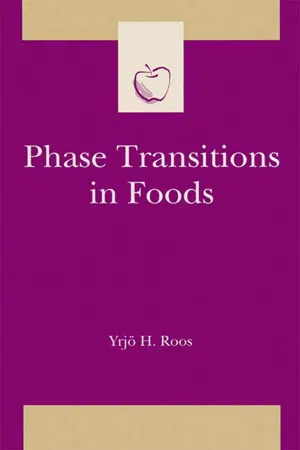I. Introduction
Phase transitions are changes in the physical state of materials, which have significant effects on their physical properties. Chemically pure compounds such as water or many organic and inorganic compounds in foods have exact phase transition temperatures. There are three basic physical states, which are the solid, the liquid, and the gaseous states. The term transition refers to the change in the physical state that is caused by a change in temperature or pressure. Heating of solid foods is often used to observe temperatures at which changes in thermal or physical properties, e.g., in heat capacity, viscosity, or textural characteristics, occur.
Water is one of the most important compounds in nature and also in foods. It may exist in all of the three basic states during food processing, storage, and consumption. The effect of water on the phase behavior of food solids is of utmost importance in determining processability, stability, and quality. Well-known examples include transformation of liquid water into ice (freezing) or water into vapor (evaporation). These transitions in phase are the main physical phenomena that govern food preservation by freezing and dehydration. Engineering and sensory characteristics of food materials are often defined by the complicated combination of the physical state of component compounds. The main constituents of food solids are carbohydrates, proteins, water, and fat. These materials may exist in the liquid state and the solid crystalline or amorphous noncrystalline state. Many of the component compounds, e.g., sugars, fats, and water, when they are chemically pure, crystallize below their equilibrium melting temperature.
Stability is an important criterion in food preservation. Materials in thermodynamic equilibrium are stable, i.e., they exist in the physical state that is determined by the pressure and temperature of the surroundings. However, most biological materials are composed of a number of compounds and they often exist in a thermodynamically nonequilibrium, amorphous state. Such materials exhibit many time-dependent changes that are not typical of pure compounds and they may significantly affect the shelf life of foods. The physical state of food solids is often extremely sensitive to water content, temperature, and time. This chapter introduces the basic terminology of thermodynamics and phase transitions, and describes the common thermodynamic principles that govern the physical state of foods.
II. Thermodynamics
Thermodynamics describes the physical state of materials in terms of basic state variables. Thermodynamics gives and defines the basis for description and understanding of the physical state at equilibrium and various transitions, which may occur due to changes in the quantities of the state variables that define the equilibrium. General principles of thermodynamics, which are reported here according to Alberty (1983), can be found in most textbooks of physical chemistry.
A. Basic Terminology
Thermodynamics describes relationships between various systems that are in equilibrium, i.e., no changes in the physical state of the systems are observed as a function of time. Such systems are often pure compounds at a given temperature and pressure. Thermodynamics may also be used to characterize differences in physical properties between various equilibrium states and the driving forces towards equilibrium. Thus, a change in temperature or pressure may introduce a driving force for a system to approach another equilibrium state. Biological materials and foods are often metastable systems and they exhibit time-dependent changes as they approach equilibrium. Temperature changes that occur over a phase transition temperature result in a change of phase. The basic quantitative concepts of thermodynamics are temperature, internal energy, and heat. These concepts are used to describe the physical state of thermodynamic systems. Obviously, the most important parameter that has to be taken into account in the definition of the physical state of any food is temperature.
Thermodynamic systems can be separated from their surroundings with boundaries. Boundaries may allow the occurrence of heat transfer between the system and its surroundings, e.g., a food product may gain heat from its surroundings. However, boundaries of an isolated system prevent all interactions of the system with its surroundings and there can be no transfer of energy or matter between the system and its surroundings. Foods are seldom isolated systems, although the principle can be applied when insulators are used to avoid rapid cooling of hot foods or warming of cold drinks. A system may also be open or closed. An open system may have transfer of both energy and matter with the surroundings. A closed system may only have transfer of energy with surroundings. In food processing food systems may be open systems, e.g., they can be heated by steam infusion, which includes transfer of matter and energy from the surroundings to the food. Foods may also be closed systems, which is true when they are hermetically sealed in containers. Systems that are uniform in all properties are called homogeneous and those containing more than one phase are heterogeneous. When systems are at equilibrium they exist in definite states and their properties have definite values. The equilibrium state is defined by state variables, which are pressure, temperature, and volume. Two state variables, i.e., pressure and temperature or temperature and volume, can be used to define the physical state of pure materials.
Thermodynamic quantities that are proportional to the amount of material are extensive functions of state. Such quantities include total energy, volume, number of moles, and mass, which depend on the amount of material in the system. Properties which are independent of the amount of material, e.g., pressure and temperature, are called intensive functions of state. The ratio of two extensive functions of state is always an intensive function of state. Intensive properties are also obtained if extensive properties are divided by the amount of material. At a thermodynamic equilibr...
